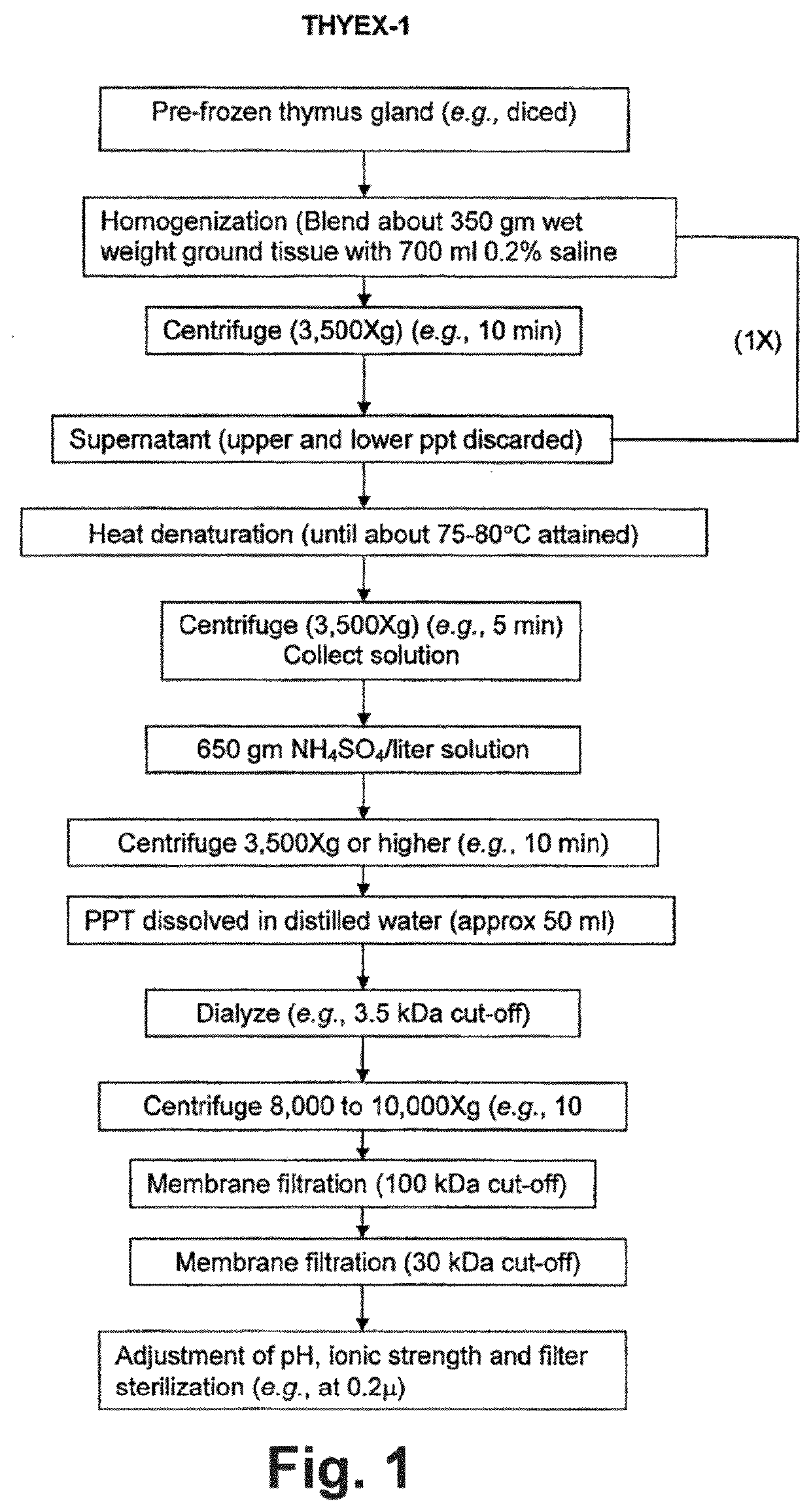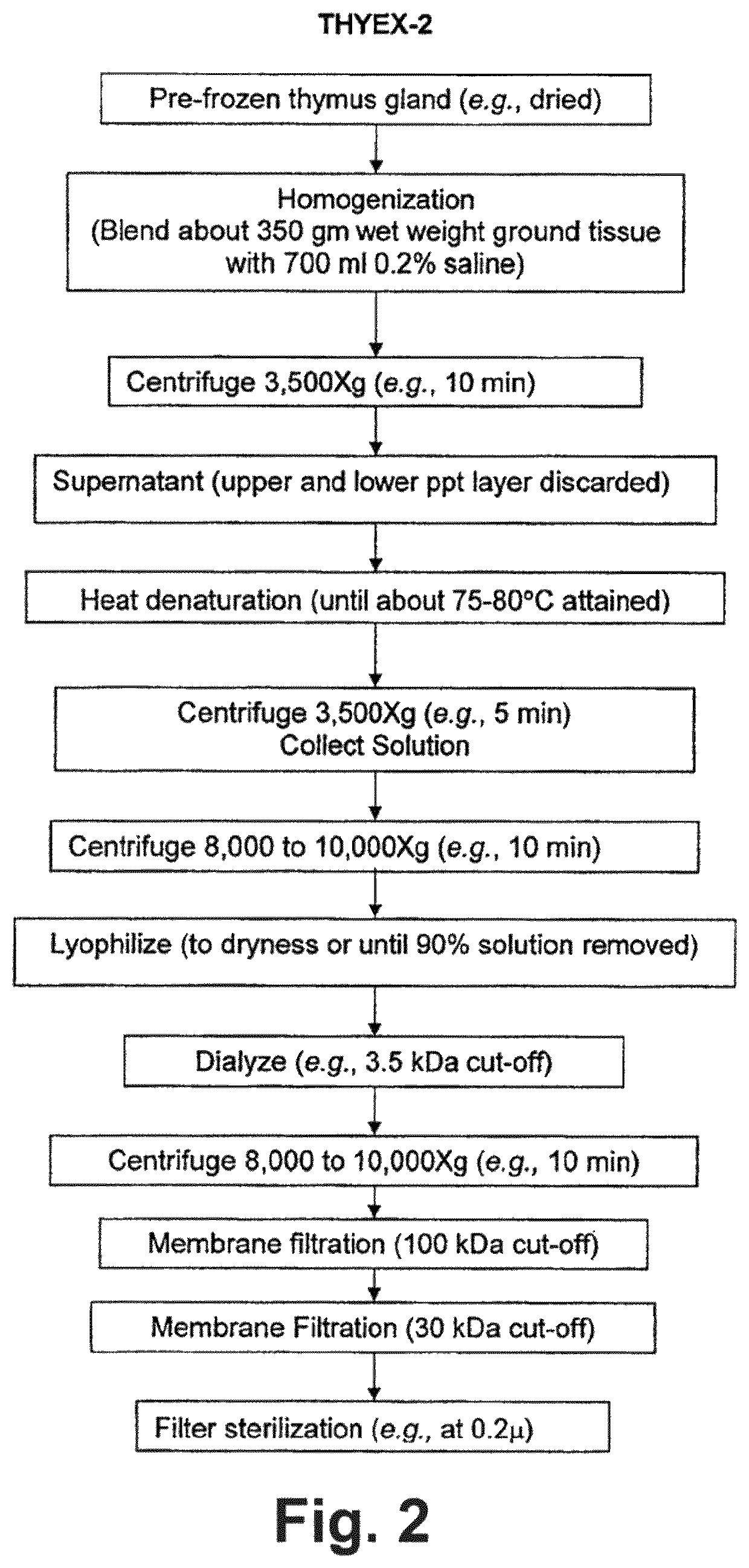Compositions and methods for treating itching, gingivostomatitis, and demodectic mange
a technology of gingivostomatitis and compositions, applied in the field of thymus, can solve the problems of life-threatening condition, pustules on the dog's skin, skin irritation, etc., and achieve the effect of modulating endocrine function
- Summary
- Abstract
- Description
- Claims
- Application Information
AI Technical Summary
Benefits of technology
Problems solved by technology
Method used
Image
Examples
example 1
Preparation of Thymus Extracts Thyex-1
[0147]This example provides an exemplary process embodiment used for preparing thymus extracts, and compositions (“Thyex-1”) produced in accordance therewith:
Thyex-1:
[0148]Thyex-1 process. The following steps (1)-(16) comprise a process embodiment for producing Thyex-1 (step (17) relates to storage) suitable for oral delivery:
[0149](1) Homogenization of thymus tissue. Fresh “prime” (i.e., not fibrous or whitish in appearance) porcine or bovine thymus glands were frozen (e.g., overnight). The frozen glands were rinsed briefly in clean water and “dressed” by removal of any associated fibrous or connective tissue, fatty tissue, or lymph node tissue. The prime washed, dressed thymus glands were cut into small pieces (e.g., about 2″ cubes using a sharp knife), and homogenized through the use of a food processor or other grinding apparatus (e.g., a meat grinder). For homogenization, a volume of approximately 700 ml of 0.2% NaCl solution (in distilled ...
example 2
Preparation of Thymus Extracts Thyex-2
[0167]This example provides an exemplary process embodiment used for preparing thymus extracts, and compositions (“Thyex-2”) produced in accordance therewith suitable for oral delivery:
Thyex-2:
[0168]Thyex-2 process. The following steps (1)-(8) comprise a process embodiment for producing Thyex-2 (step (9) relates to storage):
[0169](1) Production of “intermediate supernatant.” Steps (1)-(7) of the above-identified Thyex-1 process for the preparation of “intermediate supernatant” were followed (except that steps (1)-(3) were not repeated as in the Thyex-1 process) to produce an “intermediate supernatant” fraction;
[0170](2) High-speed centrifugation. The “intermediate supernatant” fraction of step (1) was cleared (i.e., to remove potential pathogens) by centrifugation at 8,500×g for 10 minutes at ambient temperature to produce a pellet and a cleared intermediate supernatant fraction;
[0171](3) Lyophilization. The “cleared intermediate supernatant” fr...
example 3
Preparation of Thymus Extracts Thyex-3
[0179]This example provides an exemplary process embodiment used for preparing thymus extracts, and compositions (“Thyex-3”) produced in accordance therewith suitable for oral delivery:
Thyex-3:
[0180]Thyex-3 process. The following steps (1)-(10) comprise a process embodiment for producing Thyex-3 (step (11) relates to storage), suitable for oral delivery:
[0181](1) Homogenization of thymus tissue. Fresh “prime” (i.e., not fibrous or whitish in appearance) porcine or bovine thymus glands were frozen (e.g., overnight). The frozen glands were rinsed briefly in clean water and “dressed” by removal of any associated fibrous or connective tissue, fatty tissue, or lymph node tissue. The prime washed, dressed thymus glands were cut into small pieces (e.g., about 2″ cubes using a sharp knife), and homogenized through the use of a food processor or other grinding apparatus (e.g., a meat grinder). For homogenization, a volume of approximately 800 ml of 0.2% ...
PUM
 Login to View More
Login to View More Abstract
Description
Claims
Application Information
 Login to View More
Login to View More - R&D
- Intellectual Property
- Life Sciences
- Materials
- Tech Scout
- Unparalleled Data Quality
- Higher Quality Content
- 60% Fewer Hallucinations
Browse by: Latest US Patents, China's latest patents, Technical Efficacy Thesaurus, Application Domain, Technology Topic, Popular Technical Reports.
© 2025 PatSnap. All rights reserved.Legal|Privacy policy|Modern Slavery Act Transparency Statement|Sitemap|About US| Contact US: help@patsnap.com



